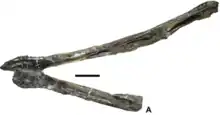Doratodon
Doratodon is an extinct genus of Late Cretaceous crocodylomorph that was once believed to be a dinosaur.[1][2] Two species of Doratodon are known to science: D. carcharidens from Austria (Grünbach Formation) and Hungary (Csehbánya Formation), the type species; and D. ibericus from Spain (Sierra Perenchiza Formation).[2][3]
| Doratodon | |
|---|---|
 | |
| Holotype mandible of D. carcharidens (specimen PIUW 2349/57) | |
| Scientific classification | |
| Kingdom: | |
| Phylum: | |
| Class: | |
| Subclass: | |
| Infraclass: | |
| Order: | |
| Suborder: | |
| Genus: | †Doratodon Seeley, 1881 |
| Type species | |
| †Doratodon carcharidens Seeley, 1881 | |
| Other species | |
| |
| Synonyms | |
| |
The holotype of D. carcharidens consists of a denture and a mandible.[4] Other specimens include a maxilla fragment, a parietal and teeth. The holotype, and only known specimen of D. ibericus, consists of an incomplete left mandible with dentation.
History
Emanuel Bunzel named the type specimen as Crocodilus carcharidens in 1871.[5] He believed it to belong to a dinosaur.[5] It was renamed as the new species Doratodon carcharidens in 1881 by Harry Govier Seeley.[1] The second species, D. ibericus, was named by Company et al. in 2005.[2] Doratodon was reassessed by Zoltan (2015).[4]
References
- H.G. Seeley, 1881, "The reptile fauna of the Gosau Formation preserved in the Geological Museum of the University of Vienna", Quarterly Journal of the Geological Society of London 37(148): 620-707
- Company, J., Suberbiola, X.P., Ruiz-Omeñaca, J.I. & Buscalioni, A.D. (2005). A new species of Doratodon (Crocodyliformes: Ziphosuchia) from the Late Cretaceous of Spain. Journal of Vertebrate Paleontology 25(2): 343–353
- https://web.archive.org/web/20060104042809/http://www.fmnh.helsinki.fi/users/haaramo/Metazoa/Deuterostoma/Chordata/Archosauria/Crocodylia/Crocodyliformes_2.html
- Zoltan Csiki-Sava, Eric Buffetaut, Attila Ősi, Xabier Pereda-Suberbiola, Stephen L. Brusatte (2015) "Island life in the Cretaceous - faunal composition, biogeography, evolution, and extinction of land-living vertebrates on the Late Cretaceous European archipelago" Zookeys" 469: 1-161 doi: 10.3897/zookeys.469.8439
- E. Bunzel. 1871. Die Reptilfauna der Gosauformation in der Neuen Welt bei Weiner-Neustadt. Abhandlungen der Kaiserlich-Königlichen Geologischen Reichsanstalt 5:1-18
